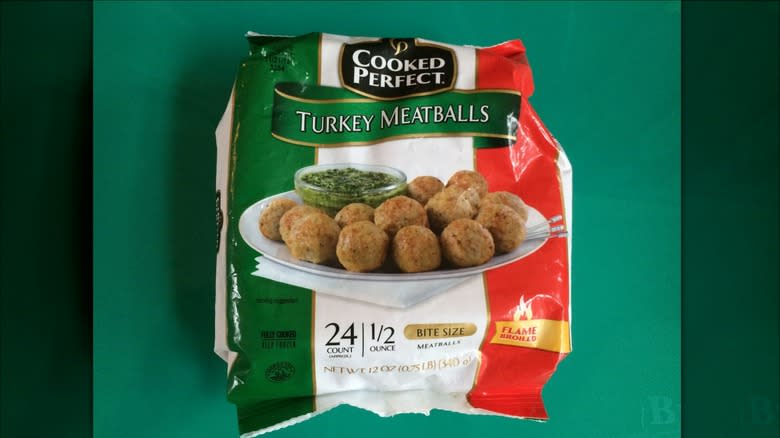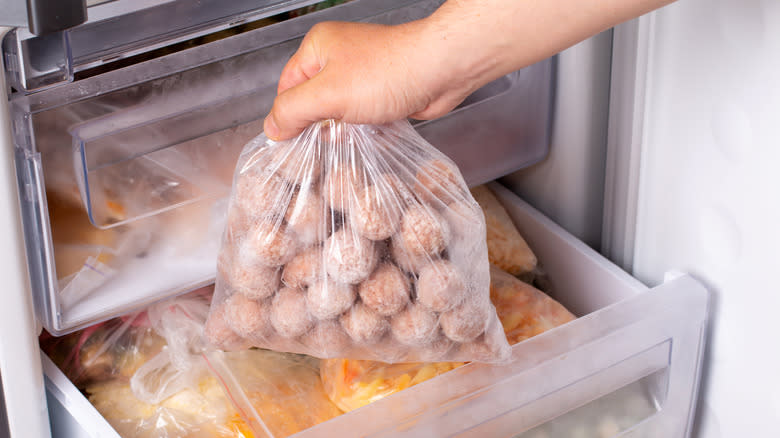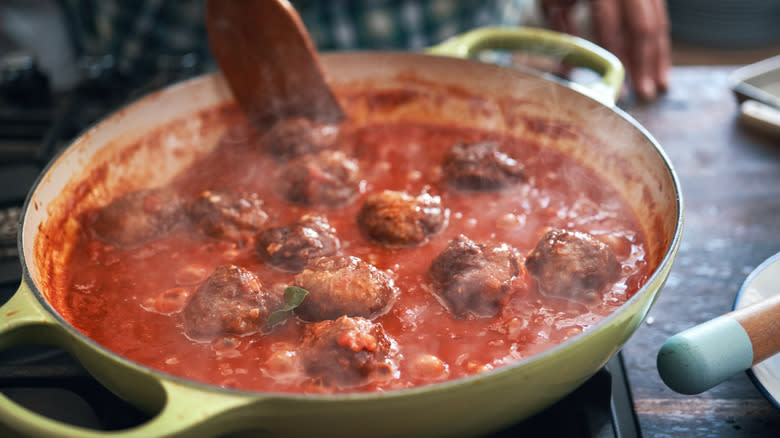12 Mistakes Everyone Makes With Frozen Meatballs

Made from ground meat, such as beef, pork, or veal, as well as ingredients like breadcrumbs, eggs, and seasoning, meatballs are the quintessential comfort food. Once these ingredients are shaped into small balls, the bites can be prepared in a huge number of ways, including frying, baking, or simmering in sauce. They're a staple in dishes like spaghetti with meatballs, as well as other culinary creations like Swedish meatballs served with a rich sauce and lingonberry jam. In the Middle East, kofta is a popular variation, often made with minced lamb or beef mixed with spices like cumin and coriander.
Keeping a stash of frozen meatballs in your freezer can be incredibly handy, given how these versatile morsels shine in such a wide range of dishes. You can easily thaw them for a quick meal, adding them to soups, stews, or even sandwiches. Moreover, you can experiment with different meatball recipes, adjusting the spices and meat types to match your preferences. Despite their simplicity, it's common for people to make mistakes when preparing and serving frozen meatballs. In addition, some fail to venture beyond cooking basic dishes, missing the opportunity to explore a variety of flavors and culinary techniques that can elevate meatballs.
Keen to know more? Keep reading to find out about the most common mistakes home chefs make with meatballs and how to avoid them!
Read more: Frozen Pizzas, Ranked From Worst To Best
Thinking That All Frozen Meatballs At The Store Are Created Equal

Frozen meatballs available at supermarkets can vary significantly in quality and flavor. Some frozen meatball brands prioritize the use of premium meats, as well as seasoning and herbs, creating a product that resembles homemade meatballs in both flavor and texture. Conversely, other brands may stuff their meatballs with fillers and preservatives to prolong the product's shelf life and lower production costs, potentially impacting both flavor and nutritional content. Frozen meatballs also vary in texture and appearance, with some looking far more appetizing than others.
While not all grocery store frozen meatballs are necessarily bad, it's important to carefully read the labels on the packaging before you purchase the kitchen staple. Aside from being low on mysterious-sounding ingredients, which are likely to be fillers and additives, high-quality meatballs will typically contain real meat as the primary ingredient. To get the most bang for your buck, look for products that list beef, veal, chicken, turkey, or pork without too many unrecognizable words on the ingredient list.
Not Making Your Own Frozen Meatballs From Scratch

There are many reasons why people might want to make their meatballs at home rather than buy frozen meatballs at the supermarket. For starters, making meatballs at home gives you almost complete control over the ingredients. This can be crucial for those with food allergies or dietary restrictions. Moreover, homemade meatballs can be customized to suit personal tastes with different types of meat, herbs, and spices. Homemade meatballs can also be made in bulk, which means that once they're frozen, you can always have them on hand as part of a convenient dinner option.
There are plenty of meatball recipes out there to explore and enjoy. For instance, homemade Italian meatballs can be both simple to prepare and very satisfying. Once rolled into balls either cook the meatballs in an Italian style sauce or freeze them for later use. Alternatively, try making Swedish meatballs by blending ground beef and pork, asking with binders and seasonings.
Overlooking The Correct Freezing Methods

Preparing a batch of homemade meatballs is an excellent method of diversifying your dinner options. However, it's crucial to use the right freezing technique to ensure they maintain the right flavor and texture. Just remember that freezing cooked and uncooked meatballs requires slightly different approaches.
If you have just made a batch of fresh meatballs and want to store them for future dinners, place them on a tray lined with parchment paper, ensuring that they don't touch. Leave the meatballs in the freezer for two to four hours to ensure that they are frozen solid. This process will help prevent the meatballs from sticking together later. Once frozen, transfer the meatballs into a freezer-safe bag or container. Be sure to mark the packaging with the freezing date, since frozen meatballs remain at their best for about two months.
When freezing cooked meatballs, let them cool before placing in the freezer. If you skip this step, you'll end up with steam inside the container that might cause freezer burn. Once the meatballs are room temperature, use the same freezing method as for uncooked meatballs. If the meatballs have been cooked in sauce, also let them cool before popping the whole lot in a freezer-safe bag or container. To make your dinners easier, divide the meatballs and sauce into individual portions prior to freezing.
Failing To Thaw Frozen Meatballs Before Cooking

As much as you may be tempted to cook frozen meatballs right out of the freezer, it's often wise to give them a bit of time to reach room temperature. Depending on the cooking method you're employing, thawing meatballs can ensure they cook evenly and thoroughly, enhancing both their texture and flavor. One of the best ways to thaw meatballs is by transferring them from the freezer to the refrigerator. Simply place the meatballs in a bowl (to catch any potential leaks), cover, and leave them in the refrigerator overnight.
There are also faster methods of defrosting meatballs if you don't have a lot of time. For instance the microwave defrost setting can be ideal for quickly thawing meatballs — just be sure to go in short bursts and check the food so as not to actually cook them. You can also thaw meatballs by putting them in a freezer bag and placing them in cold water. Some cooks also suggest that cooking frozen meatballs in sauce without defrosting them first is usually fine, as the sauce helps to evenly distribute heat and cook the meatballs. One Quora user explains: "Just make sure that you heat them gently and allow enough time to come up to heat. Although, I must say that if my late mother had ever seen me using frozen meatballs, I'd have never heard the end of it."
Not Simmering Frozen Meatballs In Sauce

Simmering meatballs in sauce not only helps to imbue them with flavor but also often makes them more tender. Just be patient, as cooking them slowly allows the flavors of the ingredients to blend seamlessly, enriching the overall taste of the dish. This is all the better of done with a tomato sauce made with fresh and high-quality ingredients as a base of the dish. Additionally, cooking the meatballs over low heat is likely to make them more tender, as it lets the heat slowly break down the proteins in the meat.
To prepare meatballs in sauce, first warm the sauce in a skillet or pot before adding the meatballs. When the sauce begins to boil, lower the heat to medium-low. Let the meatballs simmer for approximately 30 minutes or until they are fully cooked, though they can be left to simmer longer if desired. One Quora contributor shares their meatball cooking technique, saying, "If the meatballs are not huge, about 45 mins to an hour on a low simmer. You don't want to cook it too high or it will burn the bottom of the sauce. I usually cook it for around 2– 2 1/2 hours since it adds flavor to the sauce but if it cooks too long, the meatballs will fall apart."
Forgetting To Brown Frozen Meatballs Before Adding Them To The Sauce

Before adding meatballs to sauce, consider searing them in a frying pan to enhance their flavor and texture. As the meatballs sear, they should develop a rich golden-brown crust that not only improves their visual appeal but also can help to lock in juices. That's because the browning process triggers the Maillard reaction, an interaction between amino acids and sugars that produces complex flavors and browning. It also means that the meatballs are less liable to fall apart while you're cooking them in sauce.
Internet users are full of tips about making the perfect spaghetti and meatballs dish. In terms of technique, Italian American cooks sometimes emphasize frying the meatballs in olive oil until they are partially cooked, then drying them on a paper towel before simmering in sauce. One Quora user suggests sautéing the meatballs with minced garlic and onion to infuse them with additional flavors before they are submerged in sauce. One Reddit contributor recommends: "Get some nice browning on the outside, take them out, make the sauce in the same pan, put the meatballs back in, and let 'em simmer on low heat," using the fond left at the bottom to further enrich the sauce.
Not Baking Frozen Meatballs In The Oven

For a healthier alternative to traditional meatballs, consider baking them in the oven. Baking not only reduces the oil used during cooking but can also allow excess fat to drip away from the meatballs as they cook. Furthermore, time in the oven lets meatballs develop a deliciously crispy exterior while maintaining a juicy interior. Unlike frying, baking meatballs also doesn't require constant attention, which means more time for other kitchen tasks.
Another great aspect of baking frozen meatballs is ease of preparation. Simply thaw them (some home chefs forgo this step), place on a baking sheet, pop the tray in the oven, and let them cook while you prepare other parts of the meal. All you need to do is flip the meatballs once or twice to ensure they're cooked evenly.
Meatballs in sauce can also be prepared in the oven. Simply place the meatballs in a baking dish, submerge them in sauce, and cover with aluminum foil to keep it nice and moist. For added flavor, sprinkle the dish with shredded cheese once it's cooked thoroughly and let it bake until the dairy has melted.
Not Making Frozen Meatballs In A Slow Cooker

A slow cooker simmers food at a lower temperature than many other cooking methods. Although this technique takes more time, it's ideal for planning ahead. This is because the extended cooking time allows the flavors of a dish to blend together, in this case resulting in juicy and tender meatballs even if you have a busy schedule.
To cook frozen meatballs in a slow cooker, place them in the appliance without thawing, along with other ingredients such as vegetables or sauces if desired. If you're cooking frozen meatballs without sauce, add a cup of water or broth to keep them from drying out. For optimal results, set the cooker to low for four to six hours or high for two to three hours. This should ensure that the meatballs are both thoroughly cooked and tender. If you are using sauce, stir it occasionally to keep the meatballs well-coated.
Avoiding Cooking Frozen Meatballs In An Air Fryer

If you're looking for a quick and relatively healthy way to prepare frozen meatballs, an air fryer has you covered. Quality air fryers use hot air to cook food, which requires much less oil than traditional frying methods. This results in a lower fat content and fewer calories, making the meatballs a healthier dining option. Cooking meatballs in an air fryer is also super fast since there's no need to defrost them beforehand. However, if starting from frozen, it's important to preheat the device before adding the meatballs. This step will stop them from drying out externally while remaining cold inside.
For best results, preheat the air fryer to 400 degrees Fahrenheit, pop the meatballs in the basket, and cook them for around 10 minutes. Give the basket a shake halfway through the cooking process to ensure that the meatballs are cooking evenly. If you prefer them to be extra crispy, let the meatballs cook for an extra one or two minutes. This being said, it's important that you don't overcrowd the air fryer basket and keep the meatballs in a single layer. Neglecting to do this could result in some meatballs turning soggy and others becoming excessively crispy.
Overcooking Frozen Meatballs

It's crucial that meatballs are cooked thoroughly to prevent foodborne illnesses. In fact, the USDA recommends that ground meats should reach a temperature of 160 degrees Fahrenheit to ensure that they are safe for consumption. The best way to check the internal temperature of meatballs is by using a good quality food thermometer. While undercooking meatballs is a big no-no, overcooking them also isn't ideal since it can make them dry and unappetizing, or overly soggy if they happen to be cooked in sauce.
One Reddit user has shared their experience working in an Italian restaurant, where they faced just such an issue with maintaining the quality of meatballs prepared in sauce. More specifically, they observed that meatballs left in sauce on a steam table throughout the day would fall apart. The solution they found was to cook the meatballs fresh and avoid leaving them in a sauce for longer than two hours. Another Reddit contributor also describes their experience of leaving meatballs in a sauce for prolonged periods of time: "They'll go from nice, and tender, to softer, soggy and more waterlogged as time passes. They soak up moisture and become heavy, pasty, and mushy till they eventually fall apart."
Not Getting Creative With Your Frozen Meatballs

While spaghetti and meatballs is an undisputed culinary classic, its familiar comfort can sometimes overshadow other, more innovative ways to enjoy meatballs. Exploring different culinary takes on the meaty bites can open up a treasure trove of flavors. While we recommend starting with small batches of meatballs when your experimenting with new recipes. Then, once you've mastered the process, consider making larger batches of food to freeze for later.
Some of the more interesting types of meatballs from around the globe include Middle Eastern kofta, Swedish kottbullar, and Spanish albondigas. While kofta recipes vary from country to country, they're frequently made with a blend of beef, lamb, and a variety of aromatic herbs and spices. Swedish meatballs are often made with a blend of beef and pork, and paired with a rich sauce and lingonberry jam.
Meanwhile, Spanish albondigas are typically made with pork and veal, before they are simmered in a range of different sauces. Another take on meatballs are Dutch bitterballen. Made from beef, bitterballen are breaded and deep fried in oil to create a crispy exterior.
Not Following Instructions On The Packet And Cooking Expired Meatballs

When choosing frozen meatballs at the grocery store, it's wise to go beyond reading the ingredients list and nutritional information on the packaging. To that end, be sure to always check the expiration or use-by date on the packaging to ensure that the meatballs are still safe for consumption. Additionally, review the storage directions on the label to ensure the product's longevity and quality.
While technically frozen food almost never expires, the use-by dates on frozen food packaging does serve an important function. This is because frozen food can lose significant flavor and texture over time. As explained by one Quora member: "Safety is not the issue with long-term freezer storage [...] But the meatballs may actually be the mummified remains of meatballs: freezer burn can render them completely unpalatable."
When selecting frozen meatballs, it's also crucial to carefully examine the cooking instructions provided on the packaging. While most frozen meatballs purchased at grocery stores are pre-cooked, this may not always be the case. As such, raw meatballs will need to be thoroughly cooked rather than just reheated to ensure that they are safe to eat. Additionally, the packaging usually states the recommended cooking methods — such as baking or frying — and the appropriate times and temperatures to help you get the best results.
Read the original article on Mashed


